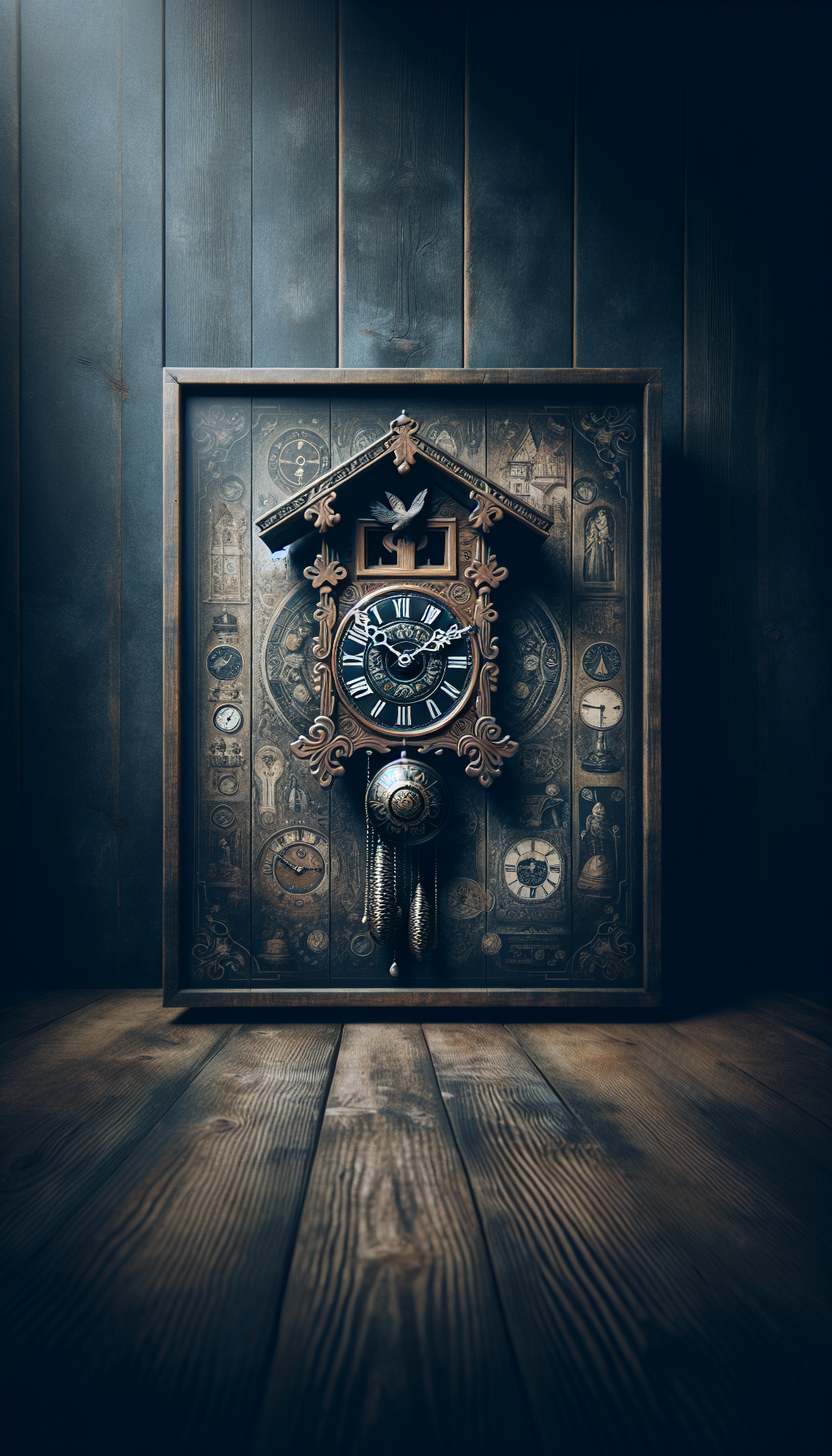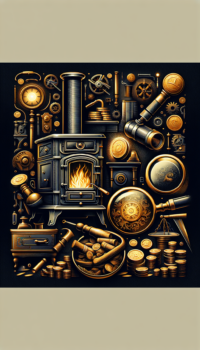An Art Deco Style Wall Hanging Clock From Circa 1980s
Interest in Art Deco never really went away. By the 1980s, a full-blown revival sent geometric forms, chrome-like accents, and mirrored surfaces back into homes—often carried by quartz wall clocks that nodded to the 1930s while embracing modern manufacturing. For collectors and appraisers, these later “Art Deco style” clocks occupy a distinct niche: they are not period Deco (c. 1925–1939), yet they can be well-designed, attractive, and increasingly collectible in their own right.
This guide explains how to identify, date, evaluate, and care for an Art Deco style wall hanging clock from the 1980s, with practical pointers for appraisal and the current market.
How to Identify an Art Deco Style 1980s Wall Clock
The first step is to separate genuine interwar Art Deco from later Deco revival. Most 1980s examples advertise themselves if you know where to look.
Key visual cues
- Motifs: stepped “skyscraper” profiles, sunburst rays, chevrons, fans, and zigzags rendered with crisp, repeatable lines.
- Surfaces: black lacquer-look finishes; mirrored glass panels with screen-printed numerals; gold-tone or chrome-like trim; sometimes smoked glass (gray/brown).
- Proportions: slimmer cases and larger dial openings than many 1930s clocks; frequent use of circular or octagonal outlines with layered frames.
- Hands and numerals: stylized Art Deco fonts, elongated or notched hands; dial graphics that look photo-printed or silk-screened rather than hand-applied.
Construction and movement
- Quartz movements: the strongest giveaway. A battery compartment (usually one AA) stamped “Quartz,” “Japan movement,” “West Germany,” “Taiwan R.O.C.,” or similar is typical. Some larger wall clocks use a C-cell or have an add-on pendulum unit driven by quartz.
- Back panels and fasteners: MDF or pressboard backs, Phillips-head screws, sawtooth or keyhole hangers. Earlier Deco clocks usually used slotted screws and heavier wood cases or cast metal backs.
- Materials: chromed ABS plastic and brass-plated steel were common in the 1980s; 1930s cases more often used solid wood, Bakelite, catalin, or heavy chrome on steel.
Brand and origin clues
- Brands you’ll encounter: Seiko, Rhythm (Japan), Bulova, Howard Miller (U.S.), Hermle (West Germany), Elgin (often for U.S. department store distribution), Seth Thomas (brand still active under later ownership), and Spartus (plastic cases).
- Labels and markings: foil labels, barcoded stickers, and “Made in” markings are strong indicators of the era. “West Germany,” “Japan,” “Hong Kong,” and “Taiwan R.O.C.” appear frequently on 1980s clocks; a plain “Germany” may indicate just-post-reunification (1990+) unless the label clearly looks older.
What Art Deco revival isn’t
- If it has a quartz module or a UPC barcode, it is not 1930s period Deco. Don’t be misled by sellers who conflate style with age. A 1980s Deco-style clock can still be desirable—just catalog it accurately.
Materials and Construction Details to Examine
Understanding what these clocks are made of will improve both identification and valuation.
Cases and frames
- Wood and MDF: many 1980s clocks use veneered MDF or painted/laminated pressboard. Look at exposed edges on the back for fiber texture and uniformity.
- Plastics: chromed ABS or polystyrene trim rings, columns, or numerals; these can pit or craze with age. Plastic often feels warm and light compared to plated brass.
- Metal: brass-plated steel or aluminum bars, bezels, and accents. Magnet test can help distinguish steel beneath plating.
Glass and mirrors
- Mirrored elements: true silvered glass shows depth and can desilver at the edges (“foxing”). Screen-printed numerals or chapter rings are common and sit atop the mirror surface.
- Crystals/lenses: flat glass on better models; acrylic on budget ones (light, slightly flexible, and prone to hairline scratches).
Dials and graphics
- Paper dials vs. screen-printed glass: paper shows aging as yellowing and edge lift; screen-printed graphics on glass remain crisp but can flake if scrubbed.
- Fonts: many 1980s dials use clean, uniform Deco-inspired fonts that lack the slight irregularities seen in some 1930s silk-screening.
Movements and hardware
- Quartz modules: typical rear stamps include “Quartz,” voltage and battery type, and sometimes a maker (Seiko, Jecko, Young Town, Hermle). Look for small date stamps or QC stickers inside the battery bay or on the movement plate.
- Hand mounting: Asian JIS-standard hands are common; European quartz movements may use a different hand-fitting standard. If you plan to replace a movement, match shaft length and hand-mounting format.
- Hangers: sawtooth hangers on pressboard backs, or two keyhole slots integrated into the case. Heavier glass/mirror clocks may use metal D-rings.
Dating and Attribution: Narrowing to “Circa 1980s”
Dating a revival-style piece benefits from multiple converging clues.
What to look for
- Country of origin wording:
- “West Germany” strongly indicates pre-1990 production.
- “Taiwan R.O.C.” regularly appears on 1970s–1980s exports.
- “Hong Kong” is most prevalent pre-1997 handover, with peak export labeling in the 1970s–80s.
- “Japan” on quartz movements aligns well with 1970s–1980s quality modules.
- Barcodes: UPC codes began appearing widely on retail goods from the late 1970s onward; a barcode label suggests late 70s–1980s or later.
- Movement details: original quartz modules may carry internal date wheels or inked codes. For example, a small “86” or “88” on a movement housing or QC sticker often denotes year.
- Retail residue: department store price stickers, inventory codes, or catalog model numbers are valuable. Brands like Howard Miller and Seiko kept consistent numbering schemes; match model numbers to period styles when possible (without assuming value solely from the brand).
Attribution tips
- Signed dial or label: give primary credit to the dial brand. If the dial reads “Bulova” but the movement is a generic module, attribute to Bulova for the overall clock but note the movement supplier if visible.
- Mixed components: replacements are common. A 1980s case with a newer movement is still a 1980s clock, but note the replaced component in any appraisal.
Condition, Function, and Restoration Considerations
Condition drives value more than any other factor for 1980s Deco revival clocks. Common issues and safe remedies:
Typical condition issues
- Plating loss and pitting: brass or chrome-like finishes can bubble or pit. Minor pitting is expected; heavy loss reduces desirability.
- Mirror desilvering: often along edges or around drilled holes. Some collectors enjoy the patina; extensive desilvering is a value hit.
- Plastic degradation: micro-cracking (crazing), UV discoloration, or brittle trim.
- Dial wear: lifting or yellowing of paper dials; flaking of printed graphics on glass if cleaned aggressively.
- Movement failure: quartz modules can drift or stop; replacing like-for-like is straightforward and generally acceptable for décor-grade pieces. Retain the original movement in a bag for provenance.
- Loose laminates: veneer or laminate lifting on MDF cases, particularly near corners.
Care and cleaning
- Glass and mirrors: use non-ammonia glass cleaner and a soft cloth. Avoid soaking edges to limit further desilvering.
- Plated trim: a mild non-abrasive polish on metal; avoid aggressive polishing on thin plating or on chromed plastic (polish can cut through the layer).
- Plastic crystals: clean with mild soap and water; polish with plastic-safe compounds only.
- Wood/MDF: dust with a soft brush; use a quality paste wax if finish is intact. Avoid water near seams.
Movement service and replacement
- Batteries: use fresh alkaline or lithium AA/C cells; remove for long-term storage.
- Hands: if the minute hand slips, gently tighten the hand nut (if present). If hands rub, adjust the hand’s slight bend to clear.
- Replacement movements: measure shaft length, case depth, and ensure hand-mount compatibility (JIS vs Euro vs American I-shaft). Keep the original parts for documentation.
Hanging safety
- Larger mirrored or glass clocks can be heavy. Use wall anchors rated for the weight, and prefer two-point mounting where possible to prevent tilt and stress on the backboard.
Market and Appraisal Insights
The market for 1980s Art Deco style wall clocks is active but selective. Values reflect design quality, brand recognition, size, materials, and condition.
General value ranges (as of recent trends)
- Basic decorative quartz with plastic trim and paper dials: approximately $40–120 in retail/online listings; lower at auction.
- Mid-quality mirrored glass or better wood-veneered cases by known brands (Seiko, Bulova, Seth Thomas under later ownership): roughly $100–250 depending on size and condition.
- Higher-end or striking designs (substantial glass/metal construction, Howard Miller studio pieces, Hermle/West German production): about $250–600. Exceptional examples with strong design or scarce variants can exceed this band in the right venue.
- Designer crossovers that blend Deco revival with contemporary 1980s aesthetics may command a premium where décor trends are strong.
What moves the needle
- Size and presence: 20–36 inch sunburst or stepped mirror clocks display well and usually outpace smaller models.
- Materials and execution: real mirrored glass and metal versus chromed plastic; clean, crisp screen-printed dials; solid construction.
- Brand and documentation: complete labels, clean logos, and original packaging or receipts enhance confidence and value.
- Condition: minimal pitting, no chips or cracks, clear glass, and a reliable movement.
- Originality: retaining the original hands and movement is a plus; discreet movement replacement is acceptable for function but should be disclosed.
Red flags and pitfalls
- Misdated listings: a quartz clock marketed as “1930s Art Deco” is revival, not period. Adjust expectations and price accordingly.
- Overpolishing and “restored” claims: buffed-through plating or repainted dials reduce authenticity.
- Structural issues: delamination, cracked mirror segments, or broken hangers can be costly to remedy.
1930s Deco vs 1980s Deco Revival: A Quick Comparative Note
- Movement: 1930s = mechanical (spring-wind or electric synchronous); 1980s = quartz battery.
- Materials: 1930s often heavy chrome on steel, Bakelite/catalin, solid wood; 1980s often MDF, mirrored glass, chromed plastics, brass-plated steel.
- Hardware: 1930s slotted screws, robust cast components; 1980s Phillips screws, stamped hangers, barcode labels.
- Graphics: 1930s screen-printed or applied numerals with period font quirks; 1980s crisp, uniform, sometimes photo-printed graphics.
- Markings: 1930s country marks without barcodes; 1980s commonly show “West Germany,” “Japan,” “Taiwan R.O.C.,” and retailer codes.
Quick Appraisal Checklist
- Verify movement type: battery-powered quartz indicates revival, not 1930s period.
- Record all labels: brand on dial, foil stickers, country of origin, barcodes, model numbers.
- Inspect materials: mirror vs acrylic, metal vs chromed plastic, wood veneer vs MDF.
- Check condition: plating pitting, mirror desilvering, dial wear, plastic crazing, chips.
- Test function: does it keep time, do hands clear, does any chime/pendulum work properly?
- Measure size: diameter/height and depth; large pieces often carry stronger value.
- Assess originality: hands, movement, glass/crystal—note any replacements.
- Photograph construction: back panel, hangers, fasteners; useful for attribution and comps.
- Note brand and origin: Seiko/Rhythm/Hermle/Howard Miller/Bulova/Taiwan R.O.C./West Germany can signal quality tier.
- Compare comps: look for similar design, materials, brand, and size in recent sales.
- Weigh restoration cost vs. value: mirror resilvering and replating can exceed market value.
- Document safely: keep any removed original parts bagged and labeled.
Frequently Asked Questions
Q: My clock has “West Germany” on the movement. Is it 1930s? A: No. “West Germany” indicates post-1949 and, for quartz movements, typically 1970s–1980s production. It’s a Deco-style revival piece.
Q: Does replacing a dead quartz movement hurt the value? A: For most 1980s Deco-style clocks, a like-for-like quartz replacement is acceptable and restores function. Keep the original movement and disclose the change. Top-tier branded examples benefit from retaining original parts when possible.
Q: How can I safely clean a mirrored Deco-style clock? A: Use a non-ammonia glass cleaner and a soft cloth, avoiding heavy moisture near the mirror edges to limit desilvering. Do not scrub printed graphics; dust them lightly.
Q: What battery should I use, and how long will it run? A: Most 1980s quartz wall clocks take a single AA cell; larger models or pendulum units may use a C cell. A fresh alkaline cell typically runs 6–12 months, depending on the movement and added features.
Q: What are typical values for 1980s Art Deco style wall clocks? A: Depending on brand, materials, size, and condition, expect roughly $40–600. Decorative plastic examples sit at the lower end; large mirrored or branded German/Japanese examples trend higher.
Accurate description and careful condition assessment will help these 1980s Deco revival clocks find appreciative buyers and the right place in a collection. While not period Art Deco, the best examples deliver the movement reliability of quartz with visual punch that reads instantly as Deco—an attractive combination for collectors and interior stylists alike.



